coolant temperature TOYOTA FJ CRUISER 2010 1.G Owners Manual
[x] Cancel search | Manufacturer: TOYOTA, Model Year: 2010, Model line: FJ CRUISER, Model: TOYOTA FJ CRUISER 2010 1.GPages: 439, PDF Size: 11.02 MB
Page 137 of 439
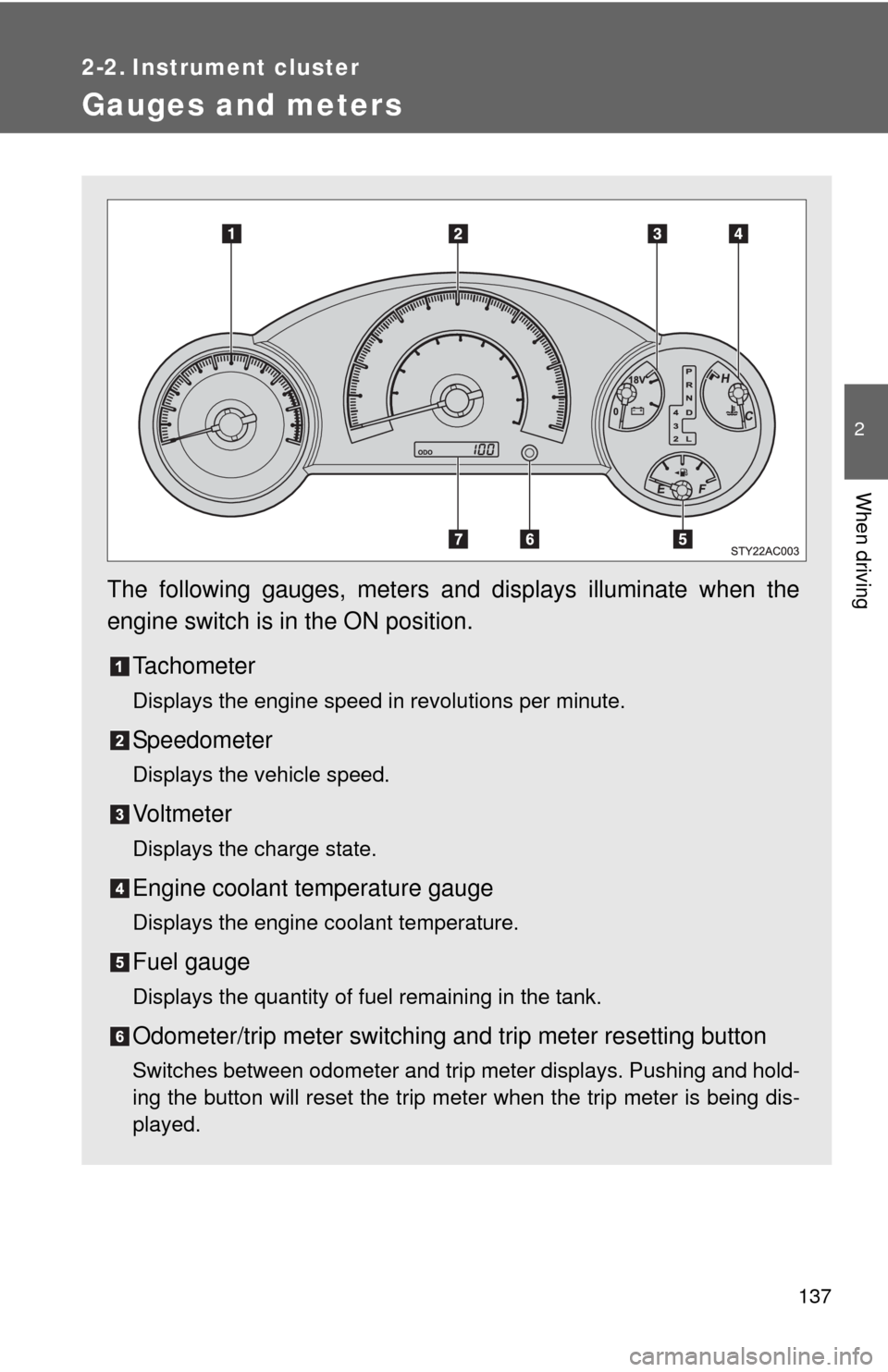
137
2
When driving
2-2. Instrument cluster
Gauges and meters
The following gauges, meters and displays illuminate when the
engine switch is in the ON position.
Tachometer
Displays the engine speed in revolutions per minute.
Speedometer
Displays the vehicle speed.
Vo l t m e t e r
Displays the charge state.
Engine coolant temperature gauge
Displays the engine coolant temperature.
Fuel gauge
Displays the quantity of fuel remaining in the tank.
Odometer/trip meter switching and trip meter resetting button
Switches between odometer and trip meter displays. Pushing and hold-
ing the button will reset the trip meter when the trip meter is being dis-
played.
Page 198 of 439

198 2-5. Driving information
●Note that when making a turn, the trailer wheels will be closer than
the vehicle wheels to the inside of the turn. Compensate by making
a larger than normal turning radius.
●Crosswinds and rough roads will adversely affect handling of your
vehicle and trailer, causing sway. Periodically check the rear to
prepare for being passed by large trucks or buses, which may
cause your vehicle and trailer to sway. If swaying occurs, firmly grip
the steering wheel, reduce speed immediately but gradually, and
steer straight ahead. Never increase speed. If you make no
extreme correction with the steering or brakes, your vehicle and
trailer will stabilize.
●Take care when passing other vehicles. Passing requires consider-
able distance. After passing a vehicle, do not forget the length of
your trailer, and be sure you have plenty of room before changing
lanes.
●In order to maintain engine braking efficiency, do not use the trans-
mission in D (automatic transmission) or 6 (manual transmission).
●Due to the added load of the trailer, your vehicle’s engine may
overheat on hot days (at temperatures over 85°F [30°C]) when
driving up a long or steep grade. If the engine coolant temperature
gauge indicates overheating, immediately turn off the air condition-
ing (if in use), pull your vehicle off the road and stop in a safe spot.
(P. 382)
Page 292 of 439
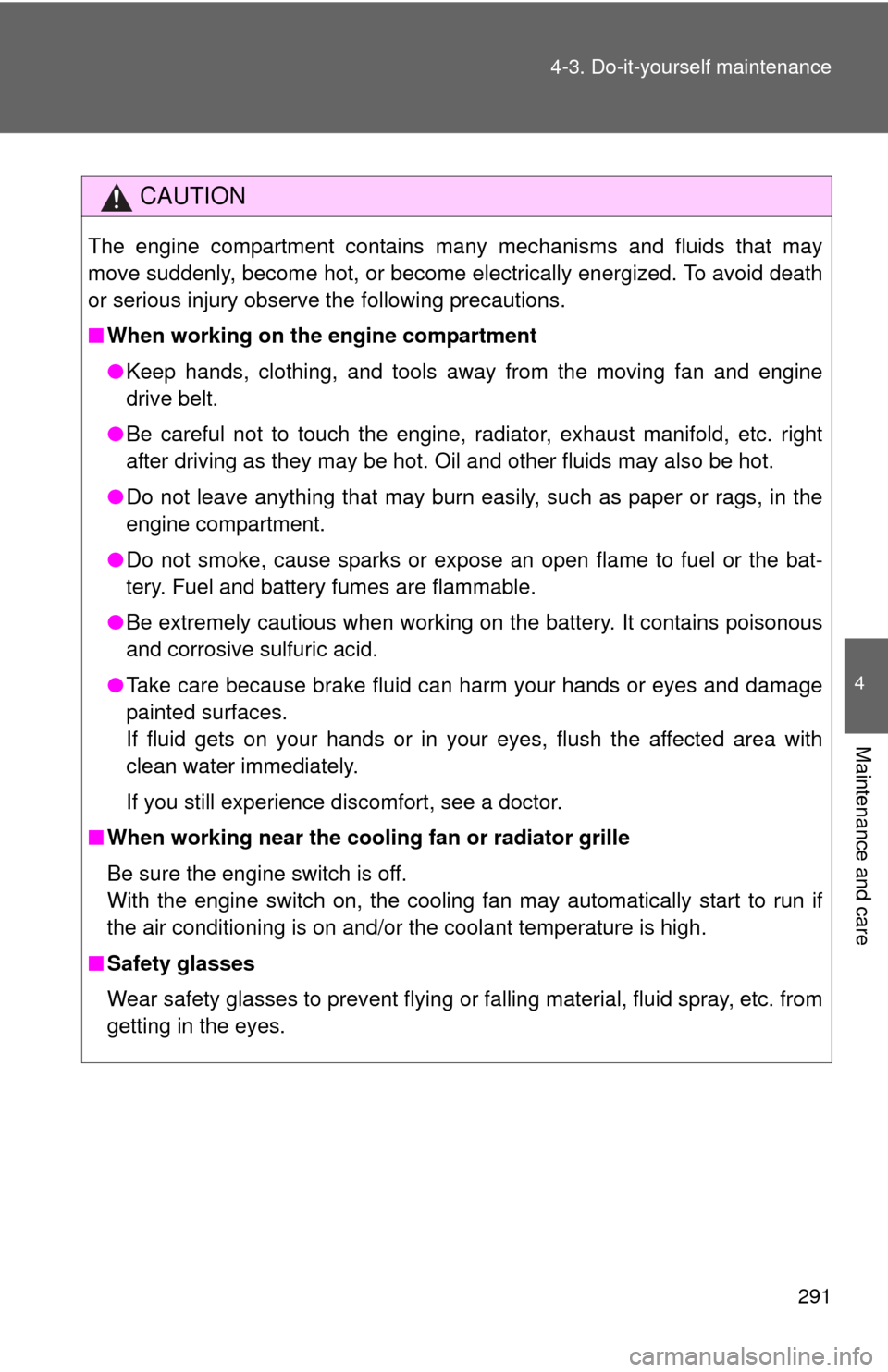
291 4-3. Do-it-yourself maintenance
4
Maintenance and care
CAUTION
The engine compartment contains many mechanisms and fluids that may
move suddenly, become hot, or become electrically energized. To avoid death
or serious injury observe the following precautions.
■When working on the engine compartment
●Keep hands, clothing, and tools away from the moving fan and engine
drive belt.
●Be careful not to touch the engine, radiator, exhaust manifold, etc. right
after driving as they may be hot. Oil and other fluids may also be hot.
●Do not leave anything that may burn easily, such as paper or rags, in the
engine compartment.
●Do not smoke, cause sparks or expose an open flame to fuel or the bat-
tery. Fuel and battery fumes are flammable.
●Be extremely cautious when working on the battery. It contains poisonous
and corrosive sulfuric acid.
●Take care because brake fluid can harm your hands or eyes and damage
painted surfaces.
If fluid gets on your hands or in your eyes, flush the affected area with
clean water immediately.
If you still experience discomfort, see a doctor.
■When working near the cooling fan or radiator grille
Be sure the engine switch is off.
With the engine switch on, the cooling fan may automatically start to run if
the air conditioning is on and/or the coolant temperature is high.
■Safety glasses
Wear safety glasses to prevent flying or falling material, fluid spray, etc. from
getting in the eyes.
Page 351 of 439
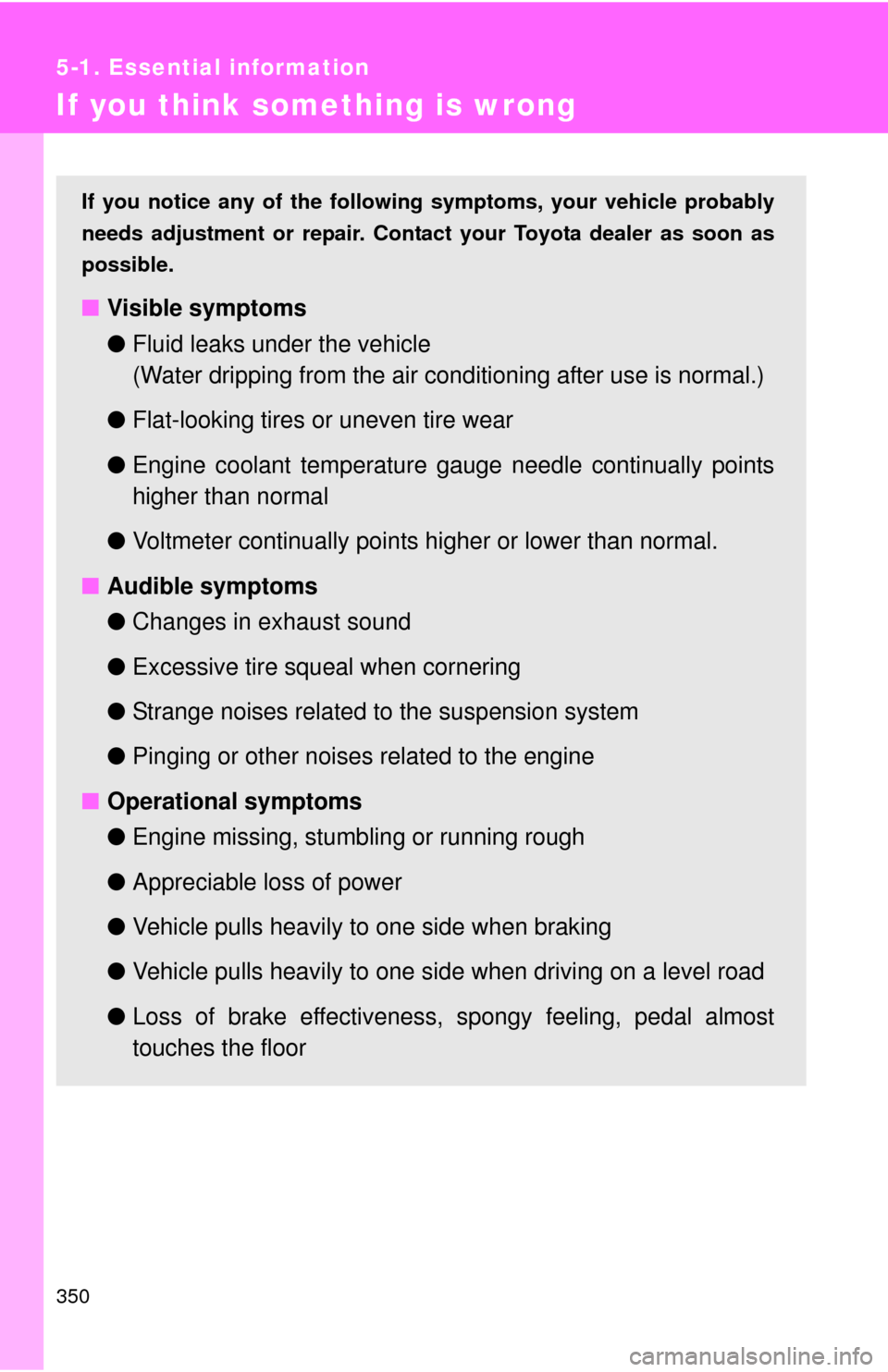
350
5-1. Essential information
If you think something is wrong
If you notice any of the following symptoms, your vehicle probably
needs adjustment or repair. Contact your Toyota dealer as soon as
possible.
■Visible symptoms
●Fluid leaks under the vehicle
(Water dripping from the air conditioning after use is normal.)
●Flat-looking tires or uneven tire wear
●Engine coolant temperature gauge needle continually points
higher than normal
●Voltmeter continually points higher or lower than normal.
■Audible symptoms
●Changes in exhaust sound
●Excessive tire squeal when cornering
●Strange noises related to the suspension system
●Pinging or other noises related to the engine
■Operational symptoms
●Engine missing, stumbling or running rough
●Appreciable loss of power
●Vehicle pulls heavily to one side when braking
●Vehicle pulls heavily to one side when driving on a level road
●Loss of brake effectiveness, spongy feeling, pedal almost
touches the floor
Page 386 of 439
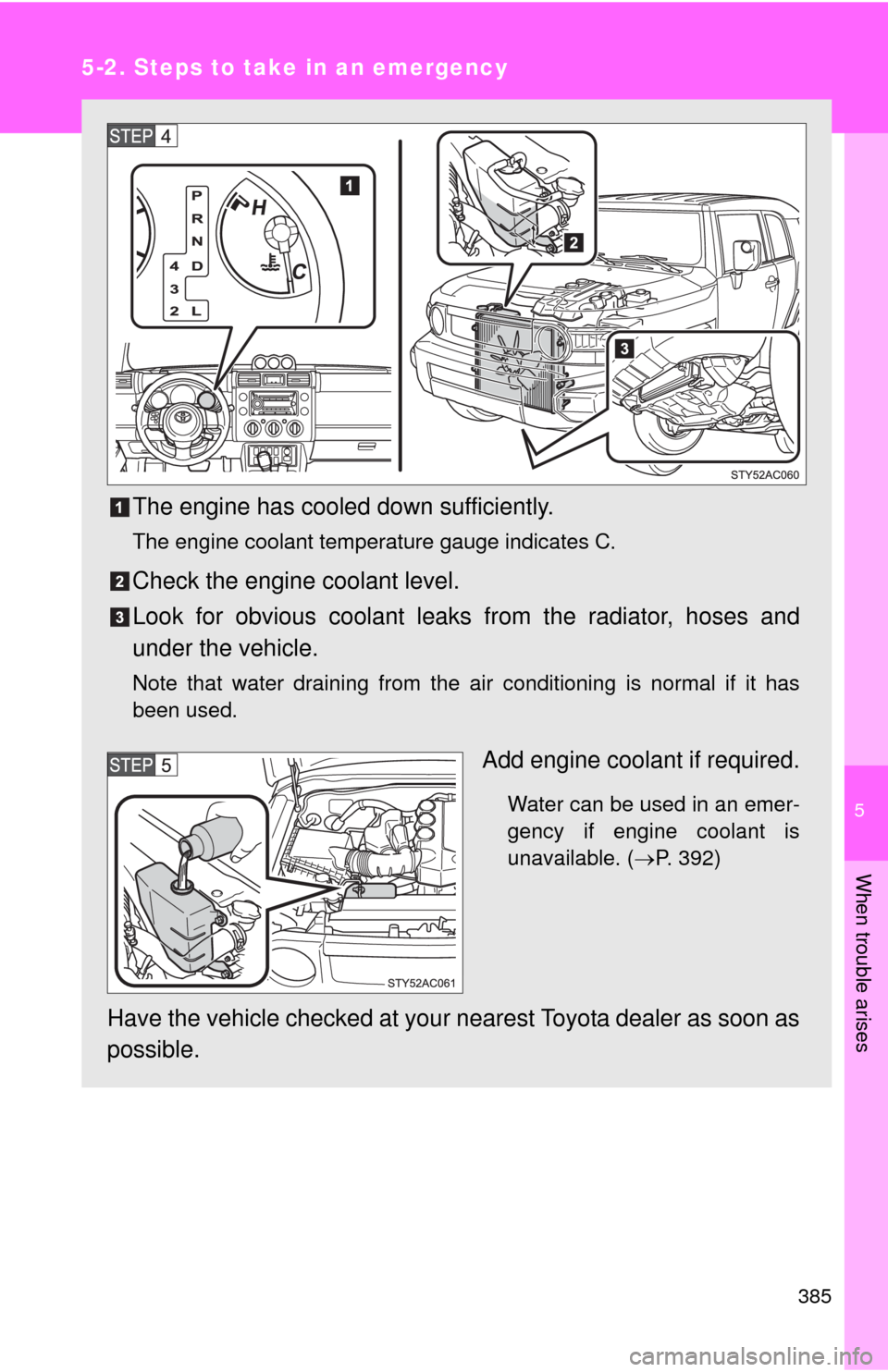
5
When trouble arises
385
5-2. Steps to take in an emergency
The engine has cooled down sufficiently.
The engine coolant temperature gauge indicates C.
Check the engine coolant level.
Look for obvious coolant leaks from the radiator, hoses and
under the vehicle.
Note that water draining from the air conditioning is normal if it has
been used.
Add engine coolant if required.
Water can be used in an emer-
gency if engine coolant is
unavailable. (P. 392)
Have the vehicle checked at your nearest Toyota dealer as soon as
possible.
Page 387 of 439
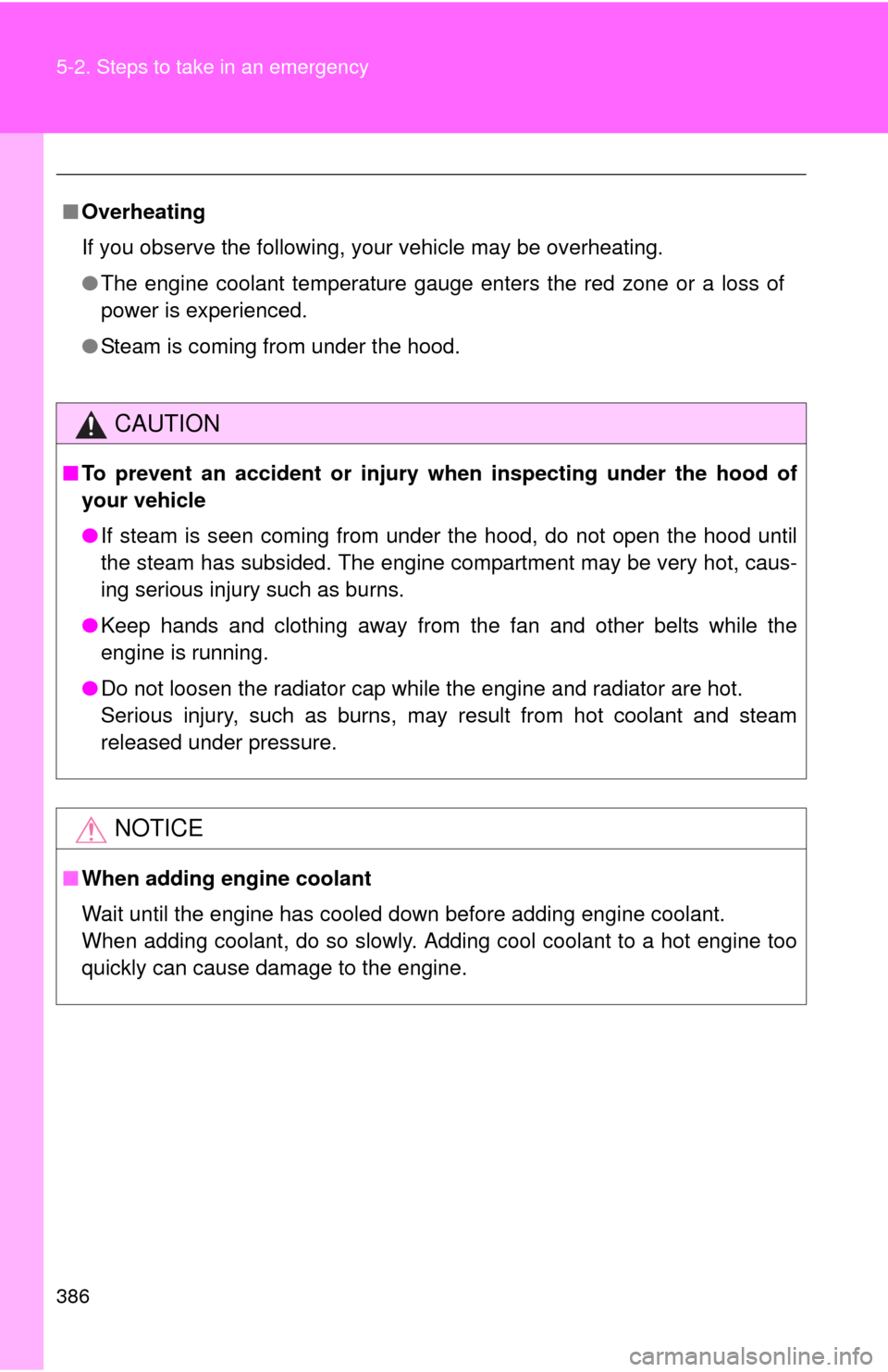
386 5-2. Steps to take in an emergency
■Overheating
If you observe the following, your vehicle may be overheating.
●The engine coolant temperature gauge enters the red zone or a loss of
power is experienced.
●Steam is coming from under the hood.
CAUTION
■To prevent an accident or injury when inspecting under the hood of
your vehicle
●If steam is seen coming from under the hood, do not open the hood until
the steam has subsided. The engine compartment may be very hot, caus-
ing serious injury such as burns.
●Keep hands and clothing away from the fan and other belts while the
engine is running.
●Do not loosen the radiator cap while the engine and radiator are hot.
Serious injury, such as burns, may result from hot coolant and steam
released under pressure.
NOTICE
■When adding engine coolant
Wait until the engine has cooled down before adding engine coolant.
When adding coolant, do so slowly. Adding cool coolant to a hot engine too
quickly can cause damage to the engine.
Page 409 of 439
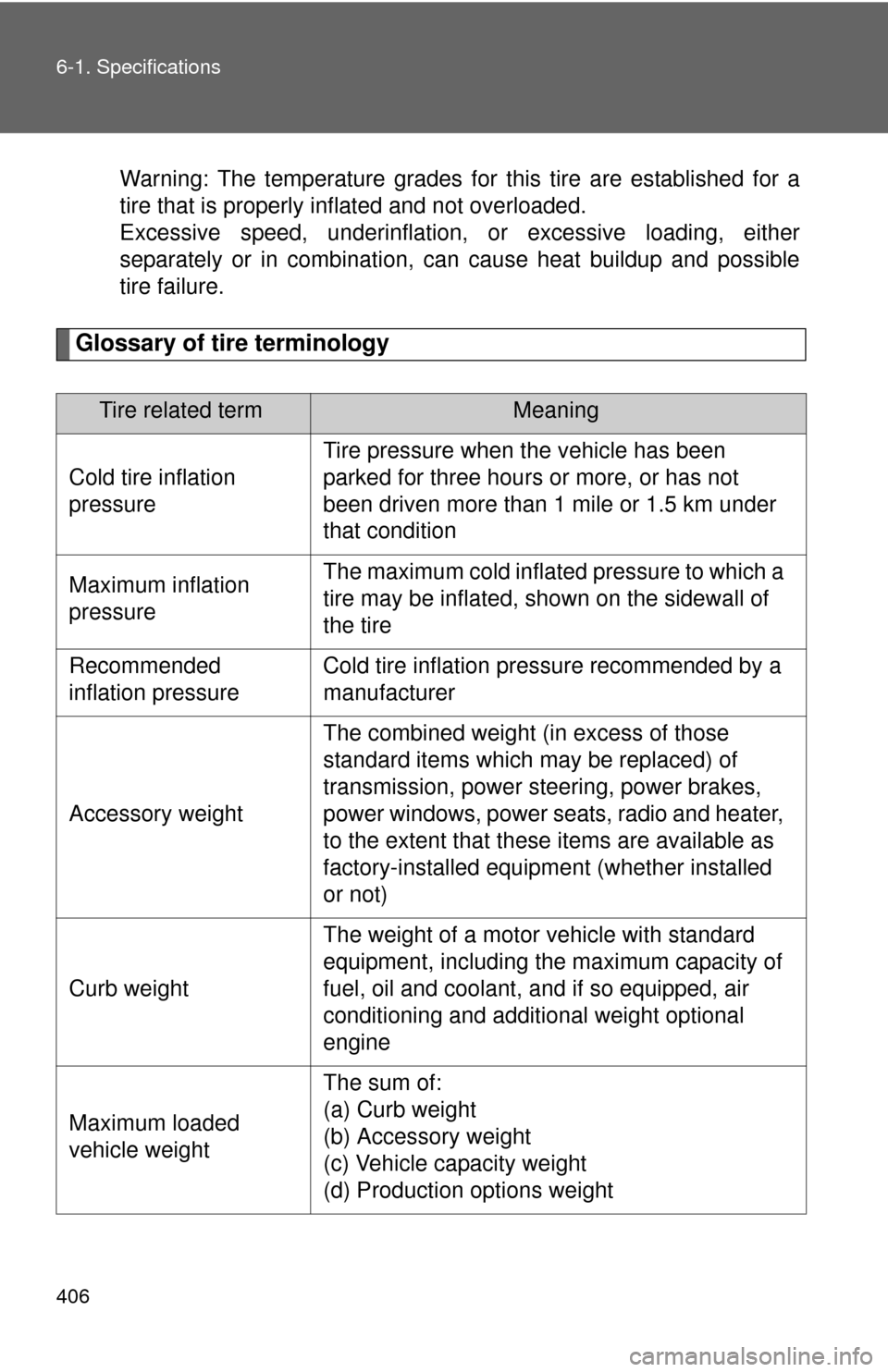
406 6-1. Specifications
Warning: The temperature grades for this tire are established for a
tire that is properly inflated and not overloaded.
Excessive speed, underinflation, or excessive loading, either
separately or in combination, can cause heat buildup and possible
tire failure.
Glossary of tire terminology
Tire related termMeaning
Cold tire inflation
pressure
Tire pressure when the vehicle has been
parked for three hours or more, or has not
been driven more than 1 mile or 1.5 km under
that condition
Maximum inflation
pressureThe maximum cold inflated pressure to which a
tire may be inflated, shown on the sidewall of
the tire
Recommended
inflation pressureCold tire inflation pressure recommended by a
manufacturer
Accessory weight
The combined weight (in excess of those
standard items which may be replaced) of
transmission, power steering, power brakes,
power windows, power seats, radio and heater,
to the extent that these items are available as
factory-installed equipment (whether installed
or not)
Curb weight
The weight of a motor vehicle with standard
equipment, including the maximum capacity of
fuel, oil and coolant, and if so equipped, air
conditioning and additional weight optional
engine
Maximum loaded
vehicle weight
The sum of:
(a) Curb weight
(b) Accessory weight
(c) Vehicle capacity weight
(d) Production options weight
Page 427 of 439

424 Alphabetical index
Emergency, in case of
Blown fuse............................. 324
If the engine will not start ...... 376
If the shift lever cannot be
shifted from P...................... 377
If the vehicle battery is
discharged .......................... 379
If a warning buzzer
sounds ................................ 354
If a warning light turns on ...... 354
If you have a flat tire ............. 364
If you lose your keys ............. 378
If you think something is
wrong .................................. 350
If the vehicle becomes
stuck ................................... 385
If your vehicle needs to be
towed .................................. 345
If your vehicle overheats ....... 382
Emergency flashers
Switch.................................... 344
Engine
Compartment ........................ 294
Engine switch ........................ 126
Exhaust gas .......................... 122
Hood...................................... 293
How to start the engine ......... 126
Identification number ............. 390
If the engine will not start ...... 376
Ignition switch........................ 126
Immobilizer system .................77
Overheating........................... 382
Warning light ......................... 355
Engine coolant
Capacity ................................ 392
Checking ............................... 299
Preparing and checking
before winter ....................... 188
Temperature gauge............... 137
Engine coolant temperature
gauge ...................................... 137
Engine immobilizer system.......77Engine oil
Capacity ................................ 391
Checking ............................... 295
Preparing and checking before
winter .................................. 188
Warning light ................. 355, 357
Engine oil maintenance
data ......................................... 297
Engine switch........................... 126
Event data recorder ................. 352
Floor mat .................................. 266
Fluid
Brake..................................... 300
Washer.................................. 306
Four-wheel drive system
Four-wheel drive control
lever .................................... 162
Front--wheel drive control
lever .................................... 164
Front passenger occupant
classification system .............. 95
Front passenger's seat belt
reminder light ........................ 357
Front passenger’s seat belt
warning buzzer ...................... 357
Front seats
Adjustment .............................. 47
Front side marker lights
Replacing light bulbs ............. 338
Switch ................................... 145
Wattage................................. 397
Front turn signal lights
Lever ..................................... 133
Replacing light bulbs ............. 338
Switch ................................... 133
Wattage................................. 397
Fuel
Capacity ................................ 390
Fuel gauge ............................ 137
Fuel pump shut off system .... 351
Gas station information ......... 436
Information ............................ 398E
F
Page 433 of 439
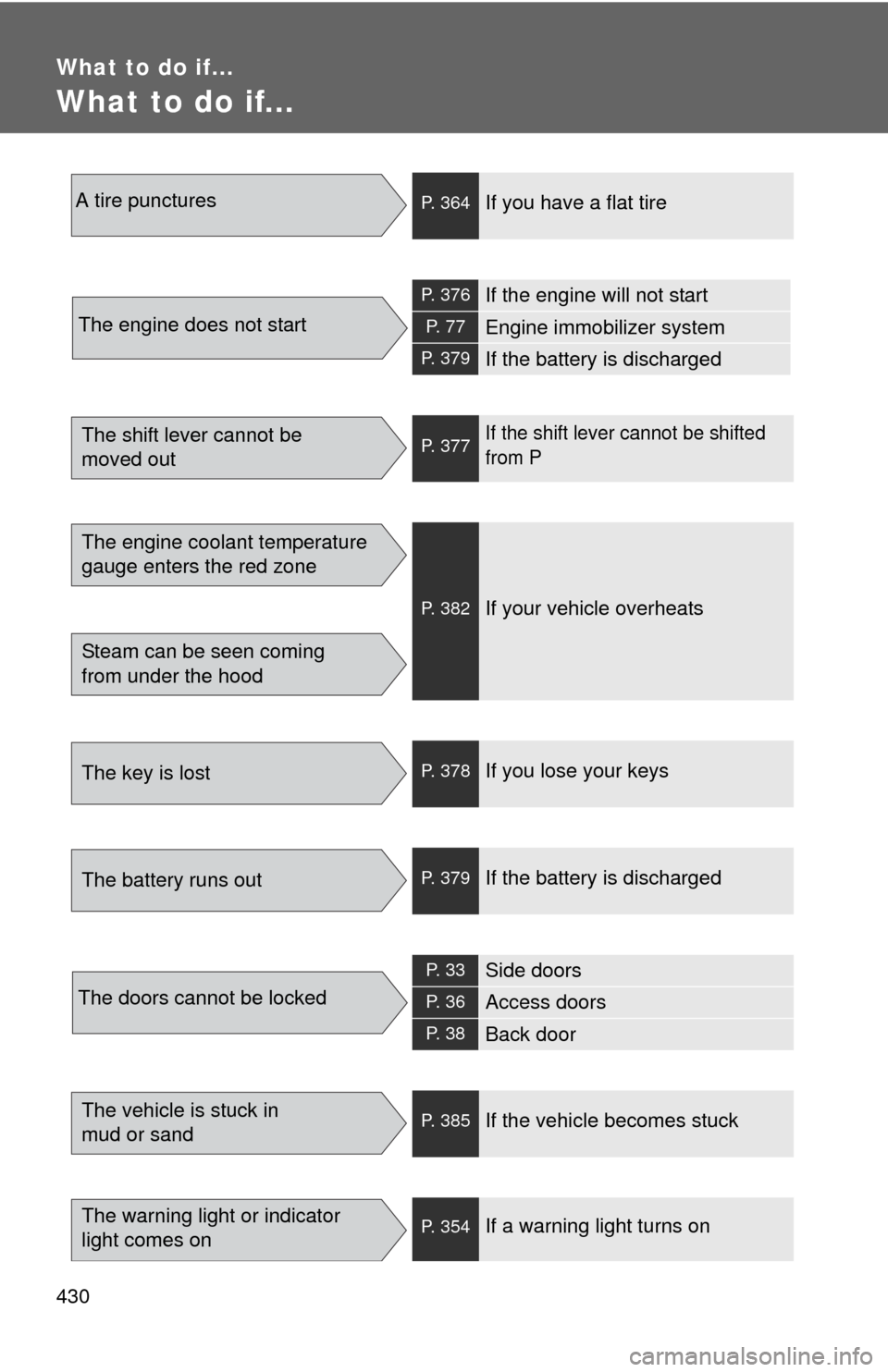
430
What to do if...
What to do if...
A tire puncturesP. 364If you have a flat tire
The engine does not start
P. 376If the engine will not start
P. 7 7Engine immobilizer system
P. 379If the battery is discharged
The shift lever cannot be
moved outP. 377If the shift lever cannot be shifted
from P
The engine coolant temperature
gauge enters the red zone
Steam can be seen coming
from under the hood
P. 382If your vehicle overheats
The key is lostP. 378If you lose your keys
The battery runs outP. 379If the battery is discharged
The doors cannot be locked
P. 3 3Side doors
P. 3 6Access doors
P. 3 8Back door
The vehicle is stuck in
mud or sandP. 385If the vehicle becomes stuck
The warning light or indicator
light comes onP. 354If a warning light turns on